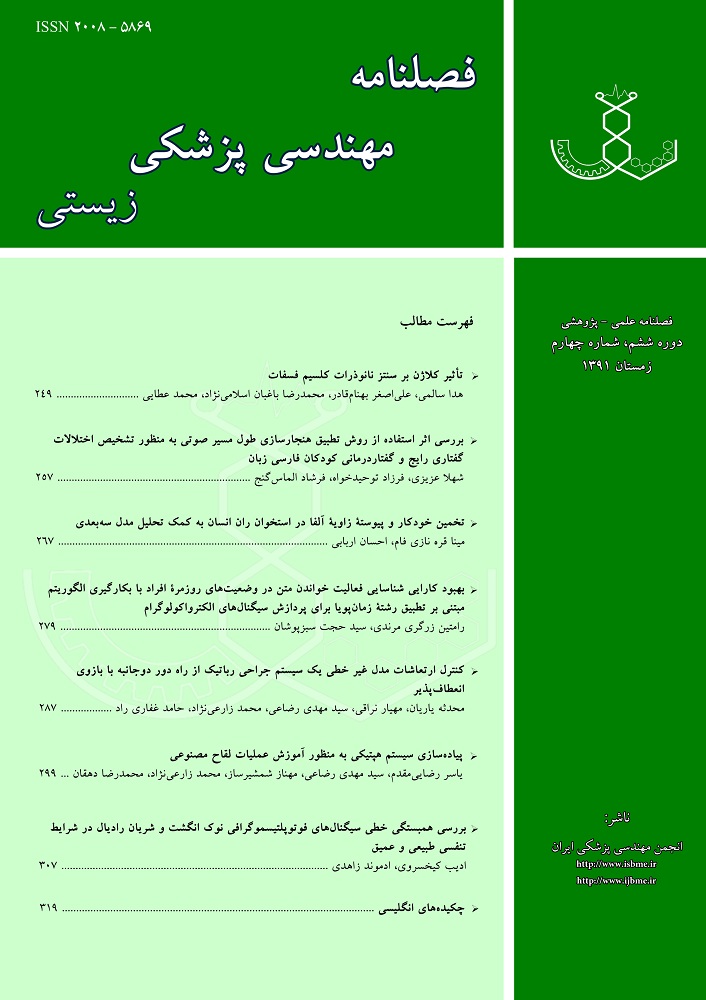نوع مقاله : یادداشت کوتاه پژوهشی
نویسندگان
1 دانشجوی دکتری مهندسی پزشکی، گروه بیوالکتریک، دانشکده مهندسی برق، دانشگاه علم و صنعت ایران
2 استادیار، گروه بیوالکتریک، دانشکده مهندسی برق، دانشگاه علم و صنعت ایران
چکیده
پژوهشهای اخیر در زمینة رایانش نافذ منجر به بهرهگیری از روشهای جدید برای شناسایی فعالیت انسان شده است. یکی از این روشها، الکترواکولوگرافی است که به کمک آن میتوان حرکات چشم را ثبت و با تحلیل الگوهای آن، فعالیتهایی مانند خواندن را شناسایی کرد. الگوی حرکتی خواندن با پردازش سیگنالهای الکترواکولوگرام (EOG) کانال افقی قابل شناسایی است؛ بنابراین در این پژوهش فقط از سیگنالهای EOGکانال افقی به جای هر دو کانال افقی و عمودی استفاده شد. با وجود کاهش تعداد کانالها و با بکارگیری الگوریتمی مبتنی بر تطبیق رشتة زمان-پویا (DTW) و استخراج الگوی مرجع خواندن به کمک تبدیل موجک و کدگذاری سیگنال EOG، کارایی دستهبندی دادههای مربوط به خواندن و نخواندن افزایش یافت. نتایج نشان داد که در کنار انحراف معیار کم نرخ شناسایی، بیشترین نرخ شناسایی 4% و میانگین بازخوانی 7% افزایش داشتند که نشاندهندة قابلیت اطمینان بیشتر الگوریتم به شرایط و افراد مختلف در مقایسه با الگوریتمهای پیشین است.
کلیدواژهها
موضوعات
عنوان مقاله [English]
Improving Reading Activity Recognition in Daily Life Situations Using DTW-Based String Matching Algorithm in EOG Signal Processing
نویسندگان [English]
- Ramtin Zargari Marandi 1
- Seyed Hojat Sabzpoushan 2
1 PhD Student, Biomedical Engineering Department, School of Electrical Engineering, Iran University of Science and Technology
2 Assistant Professor, Biomedical Engineering Department, School of Electrical Engineering, Iran University of Science and Technology
چکیده [English]
Recent research in pervasive computing field leads to use of novel techniques for human activity recognition. One of these techniques is electrooculography which helps to record eye movements and by analyzing these movements’ patterns it’s possible to recognize daily life activities like reading. Eye movement patterns during reading can be detected using only EOG signals from horizontal channel instead of both horizontal and vertical channels, so only horizontal channel electrode placement on subject’s face set up for hindrance reduction is used in this work. Despite of channels reduction and by using DTW-based string matching algorithm and reading reference template extraction using wavelet transform and encoding of EOG signal, the performance of classification between reading and non-reading data increased, As it shows 4% increase in maximum recognition rate and also low standard deviation in recognition rate in addition to 7% increase in mean of recall which demonstrate that the algorithm is more robust and reliable in comparison with previous algorithms encountering various situations and subjects.
کلیدواژهها [English]
- Electrooculography
- Context-awareness
- String Maching
- Pervasive Computing
- Pattern recognition

